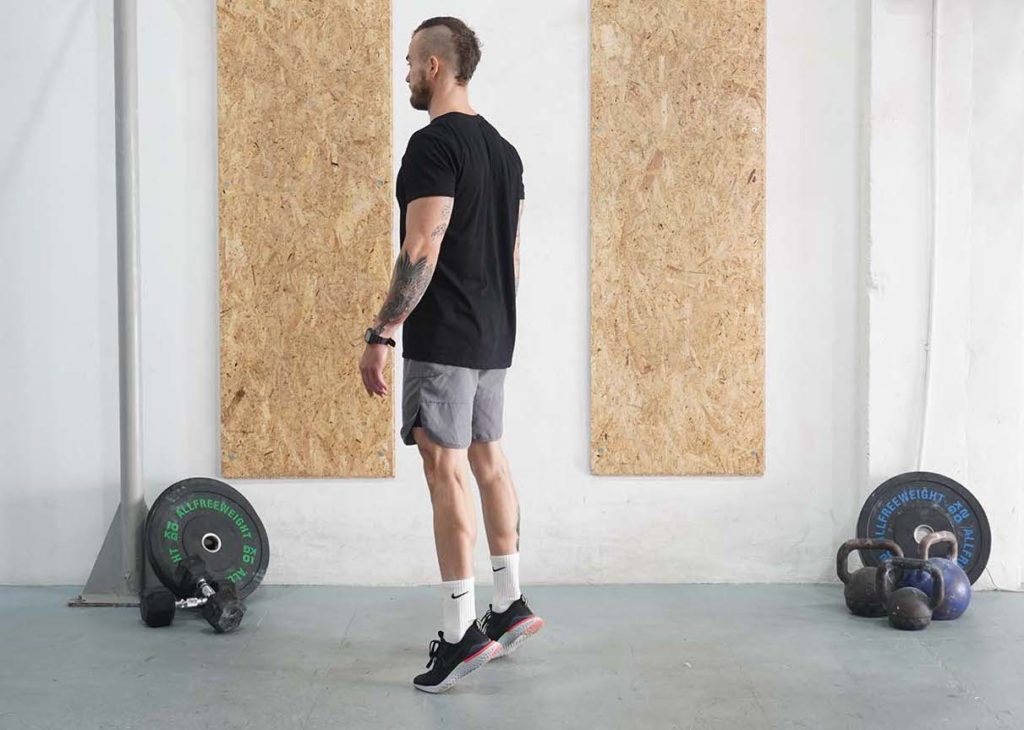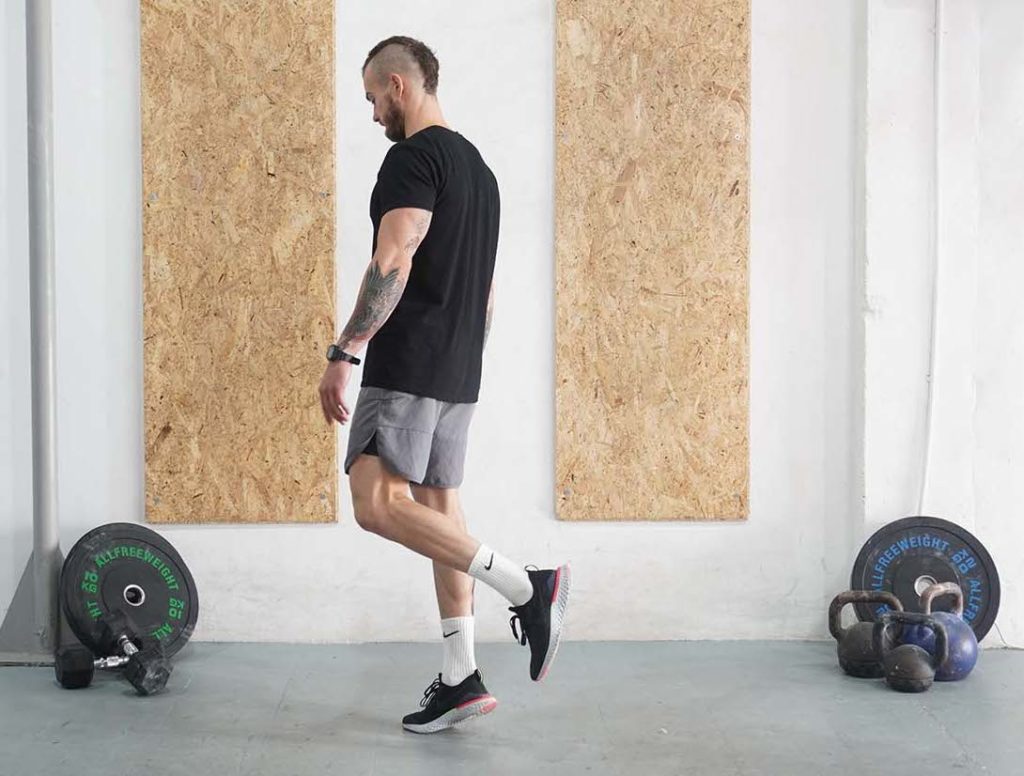Why are calf raises important?
Despite not being high on most people’s priority list, the calves are important muscles with numerous athletic and everyday functions. The calves are primarily responsible for plantarflexion (moving the foot down), but they also play a role in ankle and knee stability (1).
Our calves are involved in activities like walking, running, jumping, and weight training. For example, strong calves lead to better lower body stability, which can improve our performance on squats, lunges, deadlifts, and other similar activities.
As the primary way to train our calves, calf raises are vital for good performance and longevity in the gym. First, the movement strengthens our calves which delivers the benefits we mentioned above. Second, calf raises grow the often stubborn calves which contributes to lower body aesthetics and proportions. Third, strong calves can make everyday activities like walking and climbing stairs easier to handle, especially when we do them for long periods.
How to do Calf Raises
- Set your weight on the machine. Calf raise devices typically work with weight plates, but some offer the option to select your load with a pin.
- Adjust the thigh pad, so your thighs fit snugly as you position the balls of your feet on the platform. Doing so is vital for easier unracking and re-racking of the weight as you train.
- Place your lower thighs against the pad and position the balls of your feet on the platform. Your heels should hang in the air. Your shins should be vertical with your knees over your ankles.
- Engage your calves, take a breath, and grab the safety bar, which you’ll be moving to the side in a moment.
- Extend your feet to raise the weight and release the safety bar to the side.
- Lower the weight as much as you can, allowing your heels to travel below the level of your toes. You should feel an intense calf stretch as you do.
- Press through the balls of your feet as you engage your calves and raise the weight. Go up as much as you can. You should feel your calves contracting.
- Exhale near the top and repeat.
What muscles does a seated calf raise work?
Calf raises primarily train your calves.
The calves consist of two unique muscles:
- Gastrocnemius is the smaller two-headed calf muscle. Both heads of the gastrocnemius originate from the femur and insert into the heel. Because of this anatomical nuance, the gastrocnemius works during ankle flexion and knee flexion (2).
- Soleus is the larger muscle that lies underneath the gastrocnemius. The soleus is a powerful muscle that plays a significant role in overall calf muscle function. The soleus originates below the knee and inserts into the heel, acting only on the ankle (3).
Seated calf raises primarily train the soleus muscle because of the gastrocnemius’ origin point (4). When our knees are bent, the gastrocnemius is shortened at the knee joint, which prevents it from contracting well around the ankle. Researchers refer to this phenomenon as active insufficiency.
Tips for Seated Calf Raises
1. Focus on Training with Full Range of Motion
The most important thing to keep in mind as you do any calf raise variation is to train with a full range of motion. Meaning, lift the weight as much as you can and lower it until your heel falls below the ball of your foot. Doing so will activate your calves better, provide greater tension, and hopefully result in better results. As a rule of thumb, you should feel your calves stretch well at the bottom of each repetition. Then, upon raising the weight, your calves should contract strongly.
2. Do Slow and Controlled Repetitions
Optimal muscle growth results from placing the right amount of tension on the desired muscle. In the case of calf raises, this means doing slow and controlled repetitions, which would allow the calves to do all the work. As you do calf raises, lower the weight slowly, allow it to rest at the bottom for a second or two, and engage your calves fully on the way up. Slow and controlled repetitions might seem like something obvious to do, but many trainees find themselves bouncing the weight up and down, which lets them use heavier weights but defeats the whole purpose of the exercise.
Variations and Modifications of the Seated Calf Raises
1. Pause Calf Raises
Pause calf raises are a more challenging variation of the standard exercise. The goal with pause calf raises is to emphasize your calf muscles even more and prevent ego lifting. Doing this variation is not much different from the instructions we’ve shared above. The difference is, you would now pause at the bottom and top for at least three seconds.
Raise weight ⇒ Hold for 2-3 seconds ⇒ Lower weight ⇒ Hold for 2-3 seconds
2. Standing Calf Raises

The standing calf raise is among the most popular variations. As its name suggests, the standing calf raise means moving from a standing position with your knees straight. Doing so will allow you to prioritize the gastrocnemius muscle over the soleus.
Mistakes to Avoid
One of the most common mistakes people make with the seated calf raise is to use too much weight, which prevents them from doing the full range of motion. In most cases, trainees would lift the weight a couple of inches, lower it until their heels are at toe level, and go back up again. While not terrible, this range of motion prevents optimal calf training because each repetition lacks a solid stretch.
Another common mistake that often comes from general disinterest in calf training is to use the same repetition range forever. Our calves primarily consist of slow-twitch muscle fibers, which means they respond well to high repetition training. But this isn’t to say that we also shouldn’t train in the moderate (12 to 20) and low (6 to 12) ranges. Mixing it up is beneficial for optimal motor unit recruitment and for causing adequate mechanical tension and metabolic stress (5).
The third common mistake is bouncing, which typically comes from lifting too much weight. Instead of moving the weight slowly from start to finish, trainees use excessive momentum to lift it and then allow it to drop, creating a bouncing appearance. The problem is, bouncing takes the tension away from the calves and instead forces our Achilles tendons to absorb the force. Instead of strengthening our calves, we overwork our connective tissues and increase the risk of injuries.
Similar Exercises to the Seated Calf Raise
Standing Calf Raise (Machine)
Standing machine calf raises are quite effective and involve the gastrocnemius muscle better since it crosses the ankle and knee joints. Other than that, the standing version has an identical movement pattern to seated calf raises.
Standing Single-Leg Calf Raise

Standing single-leg calf raises help work one side at a time, preventing muscle imbalances. Similar to standing machine calf raises, this variation activates the gastrocnemius better. Plus, you can do these without any equipment, apart from having somewhere to elevate your foot.
Donkey Calf Raise
Donkey calf raises have the same movement pattern as seated calf raises. Since your legs are straight for this exercise, the donkey calf raise is also great for developing the gastrocnemius muscle. The primary difference is, you have to bend forward to do these.
Seated Calf Raise (Dumbbell)
Seated dumbbell calf raises are essentially the same exercise. The only difference is, you can do these if you don’t have access to a seated calf raise machine. Sit down, elevate the balls of your feet on something (for example, a calf raise platform), and place a pair of dumbbells on your thighs for resistance.

